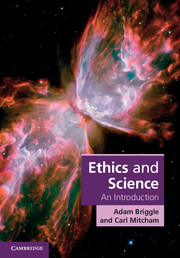Book contents
- Frontmatter
- Contents
- List of figures and tables
- Preface
- 1 Introduction and overview
- 2 Ethical concepts and theories
- 3 Science and its norms
- 4 Research ethics I
- 5 Research ethics II
- 6 Research ethics III
- 7 The science of ethics
- 8 Transition
- 9 Science and politics I
- 10 Science and politics II
- 11 Science and ideational culture
- 12 Science applied
- Epilogue Looking back, leaning forward
- Appendix Ethics codes
- Bibliography
- Index
- References
12 - Science applied
Ethics and engineering
Published online by Cambridge University Press: 05 November 2012
- Frontmatter
- Contents
- List of figures and tables
- Preface
- 1 Introduction and overview
- 2 Ethical concepts and theories
- 3 Science and its norms
- 4 Research ethics I
- 5 Research ethics II
- 6 Research ethics III
- 7 The science of ethics
- 8 Transition
- 9 Science and politics I
- 10 Science and politics II
- 11 Science and ideational culture
- 12 Science applied
- Epilogue Looking back, leaning forward
- Appendix Ethics codes
- Bibliography
- Index
- References
Summary
The final chapter once again expands appreciation of the ethical dimensions of science, this time into the domain of engineering. Expansion is justified insofar as engineering is a kind of applied science – although that is not all it is. Additionally, all scientific research is increasingly dependent on engineered instrumentation to form the interactive technoscience that founds the contemporary human-built world. Scientific engineers who have been at the forefront of constructing this world have also been leaders in ethical reflection on professional responsibilities. Codes of ethics for engineers, for instance, anticipated codes of ethics for scientists by more than half a century. Considering the ethics–engineering relationship is thus useful both to help place the ethics–science relationship in perspective and to stimulate further reflection on that relationship.
Setting the stage: the Challenger and Columbia disasters
After the Manhattan Project, one of the most iconic and important fusions of science and engineering was the US Apollo program, launched in a 1961 speech by President John F. Kennedy when he announced the goal of “landing a man on the moon” by the end of the decade. Scientists and engineers worked together to design a vehicle and sociotechnical system capable of accomplishing a politically defined goal. The Cold War successor to the Apollo program was created in 1972 when President Richard Nixon announced that NASA (the US National Aeronautics and Space Administration) would develop a permanent space station and reusable shuttle to provide regular service between it and Earth. The original vision was of a shuttle that would be, not just politically but also commercially, beneficial and provide regular service by the mid-1980s.
- Type
- Chapter
- Information
- Ethics and ScienceAn Introduction, pp. 290 - 318Publisher: Cambridge University PressPrint publication year: 2012

